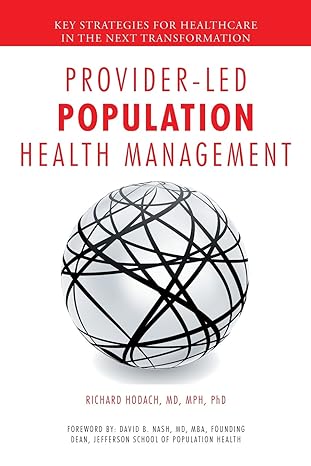Go back


Provider Led Population Health Management Key Strategies For Healthcare In The Next Transformation(1st Edition)
Authors:
Richard Hodach

Cover Type:Hardcover
Condition:Used
In Stock
Include with your book
Free shipping: April 04, 2024Popular items with books
Access to 3 Million+ solutions
Free ✝
Ask 10 Questions from expert
200,000+ Expert answers
✝ 7 days-trial
Total Price:
$0
List Price: $30.94
Savings: $30.94(100%)
Book details
ISBN: 1496941748, 978-1496941749
Book publisher: AuthorHouse
Get your hands on the best-selling book Provider Led Population Health Management Key Strategies For Healthcare In The Next Transformation 1st Edition for free. Feed your curiosity and let your imagination soar with the best stories coming out to you without hefty price tags. Browse SolutionInn to discover a treasure trove of fiction and non-fiction books where every page leads the reader to an undiscovered world. Start your literary adventure right away and also enjoy free shipping of these complimentary books to your door.
Provider Led Population Health Management Key Strategies For Healthcare In The Next Transformation 1st Edition Summary: Provider-Led Population Health Management draws connections among the new care-delivery models, the components of population health management, and the types of health IT that are required to support those components. The key concept that ties all of this together is that PHM requires a high degree of automation to reach everyone in a population, engage those patients in self-care, and maximize the chance that they will receive the proper preventive, chronic, and acute care. In the course of explaining how to do this, we describe how health-care organizations are transforming themselves to manage population health and prepare for value-based reimbursement. The ACO, PCMH, and CIN models are discussed, and the advent of bundled payments will also have a major impact on hospital and post-acute care. But at its core, the transition to accountable care centers on care teams that take responsibility for managing and coordinating the services provided to individual patients. These care teams must also engage patients in caring for themselves and improving their health behavior. As care teams become more sophisticated, many of them will use Lean thinking to continuously improve their own work processes. The book is laid out in three sections that progress from the general to the particular aspects of population health management. Section 1, entitled "New Delivery Models," first explains what PHM is and why it's important. Ensuing chapters cover ACOs and patient-centered medical homes, which are the favored vehicles for PHM. Section 2, "How to Get There," discusses some fundamentals of the new delivery models, starting with the impact of Meaningful Use on the IT infrastructure that provider organizations must build to operationalize PHM. Other chapters in this section address clinical integration, predictive-modeling applications, and the return on investment in IT solutions that help organizations take advantage of value-based payments. Section 3, "Implementing Change," describes how organizations can use health IT to manage population health. This begins with the basics of care coordination and moves on to advanced methods of care management that utilize Lean thinking. Following a chapter on overall methods of patient engagement, we finish up with a discussion of post-discharge automation, which is another way to involve patients in their own care. Finally, in a brief concluding chapter, we suggest some next steps for organizations heading down the road to population health management. While this book is intended for health-care executives and policy experts, anyone who is interested in health care can learn something from its exploration of the major issues that are stirring health care today. In the end, the momentous changes going on in health care will affect all of us.
Customers also bought these books
Frequently Bought Together
Top Reviews for Books
Ali Lo.
( 4 )
"Delivery was considerably fast, and the book I received was in a good condition."










